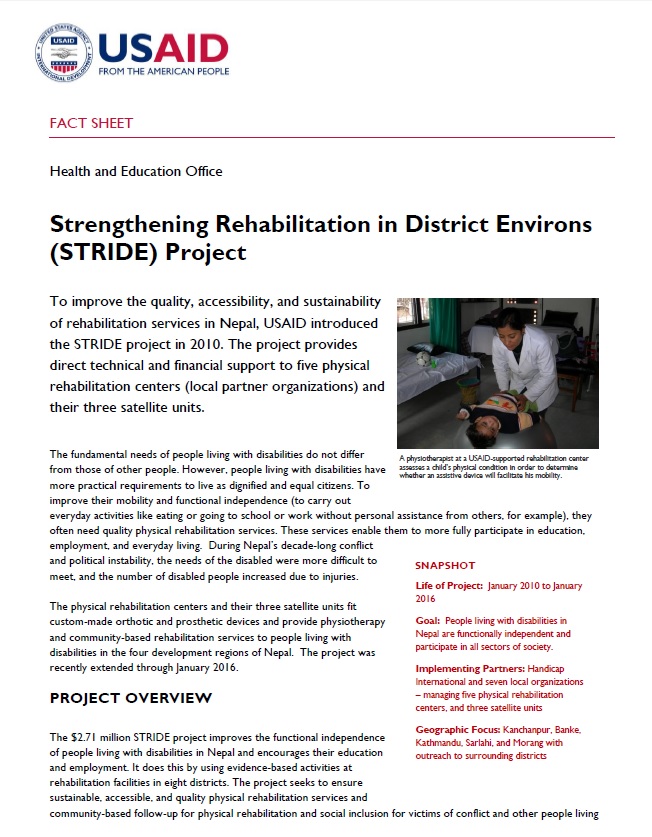The fundamental needs of people living with disabilities do not differ from those of other people; however, people living with disabilities have more specific practical requirements to live as dignified and equal citizens. To improve their mobility and functional independence (e.g., to carry out everyday activities like eating or going to school or work without personal assistance from others), they often need quality physical rehabilitation services. These services enable fuller participation in education, employment and everyday living. During Nepal’s decade-long conflict and political instability, the needs of the disabled were more difficult to meet, and the number of disabled people increased due to injuries.
These physical rehabilitation centers and their three satellite units fit custom-made orthotic and prosthetic devices and provide physiotherapy and community-based rehabilitation services to people living with disabilities in the four development regions of Nepal. The project was recently extended through January 2016.
PROJECT OVERVIEW
Through evidence-based activities occurring at rehabilitation facilities in eight districts, the $2.71 million STRIDE project improves the functional independence of people living with disabilities in Nepal and encourages their participation in education and employment. The project seeks to ensure sustainable, accessible and quality physical rehabilitation services and community-based follow-up for physical rehabilitation and social inclusion for victims of conflict and other people living with physical disabilities.
PROJECT ACTIVITIES
- Improved quality of services – STRIDE enhances the skills and capacity of partner organization staff to deliver physical rehabilitation services through formal training and on-the-job coaching. The program provides support for human resources, consumables like plastic powders used in the making of prosthetic or orthotic devices, and tools/equipment to improve the capacity of the rehabilitation center/satellite units.
- Extended access to rehabilitation services – Increasing people’s access to services by organizing mobile camps in remote areas; operating satellite units in hilly districts; mobilizing community workers, district public offices/community-based organizations; and providing financial support to some of the most vulnerable.
- Integrated into community life – Fostering the integration of persons with disabilities into their communities in 13 districts through personalized social support to 2,000 persons with disabilities, including disabled ex-combatants. STRIDE provides counseling and linkages to existing, appropriate livelihood programs and related vocational training opportunities and helps community development workers advocate for rehabilitation of physical disability through local government planning procedures and budget mechanisms.
- Enhanced organizational sustainability – Enhancing sustainability of the physical rehabilitation centers by establishing linkages and partnerships between the rehabilitation service providers, GON authorities, and disabled people organizations. STRIDE works to strengthen the national, district, and local network of disability actors and stakeholders; and, strengthen GON-operated community-based rehabilitation programs.
KEY OUTCOMES
- Eight technicians have completed an 18-month technical training in India and 15 Community Disability Workers completed a 3-month primary rehabilitation therapy course at the Hospital for Rehabilitation of Disabled Children.
- 27,300 people living with disability receive quality physical rehabilitation services including reconstructive/ surgical intervention.
- Secured funds in five rehabilitation centers with a progressive trend of 60%, 70% and 80% of their operating cost by years 1, 2 and 3.
- 2,000 persons with disabilities (including 500 disabled ex-combatants) benefit from social integration through personalized social support in the field of livelihoods.
- An increasing number of District Development Committee and Village Development Committee entities dedicate a portion of their budgets to physical rehabilitation activities.
- A comprehensive management system for self-assessment and planning for quality rehabilitation indicators is in place and periodically updated in all the five supported centers.








Comment
Make a general inquiry or suggest an improvement.